Glaze identification
+2
climberg64
Nik
6 posters
Page 1 of 2
Page 1 of 2 • 1, 2 
 Glaze identification
Glaze identification
Does anyone know of a decent site or sites that illustrate the appearance of different glazes (and firing techniques)? There are, of course, things scattered across the web; I appreciate that there may be many variables that influence the appearance of any given glaze, but I would certainly find it a useful learning resource if the information were together and readily comparable.
If not, is this a suitable candidate for a new theme here?
If not, is this a suitable candidate for a new theme here?

Nik-
 Number of posts : 265
Number of posts : 265
Location : Southport
Registration date : 2011-11-02
 Re: Glaze identification
Re: Glaze identification
There are a lot of factors that affect the glaze appearance.
The substance used; any mineral can form a glaze. I have a chart with 28 different chemical glazes which can be mixed together making a huge number of combinations.
The type of clay; something in the clay, often iron, reacts with the glaze. Dark or light clays show through translucent glazes.
The firing temperature; low temp fired earthenware will look different to high temp fired stoneware or porcelain.
The firing conditions; high oxygen (oxidation) or low oxygen (reduction firing). The atmosphere of the air in the kiln, smoke, salt etc. Fast or slow firing and cooling. Anagama single chamber kilns produce a good effects (anagama.co.uk).
I have picked out some examples.
The substance used; any mineral can form a glaze. I have a chart with 28 different chemical glazes which can be mixed together making a huge number of combinations.
The type of clay; something in the clay, often iron, reacts with the glaze. Dark or light clays show through translucent glazes.
The firing temperature; low temp fired earthenware will look different to high temp fired stoneware or porcelain.
The firing conditions; high oxygen (oxidation) or low oxygen (reduction firing). The atmosphere of the air in the kiln, smoke, salt etc. Fast or slow firing and cooling. Anagama single chamber kilns produce a good effects (anagama.co.uk).
I have picked out some examples.
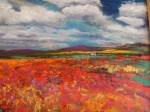
climberg64- Number of posts : 1254
Location : North East
Registration date : 2010-01-20
 Re: Glaze identification
Re: Glaze identification
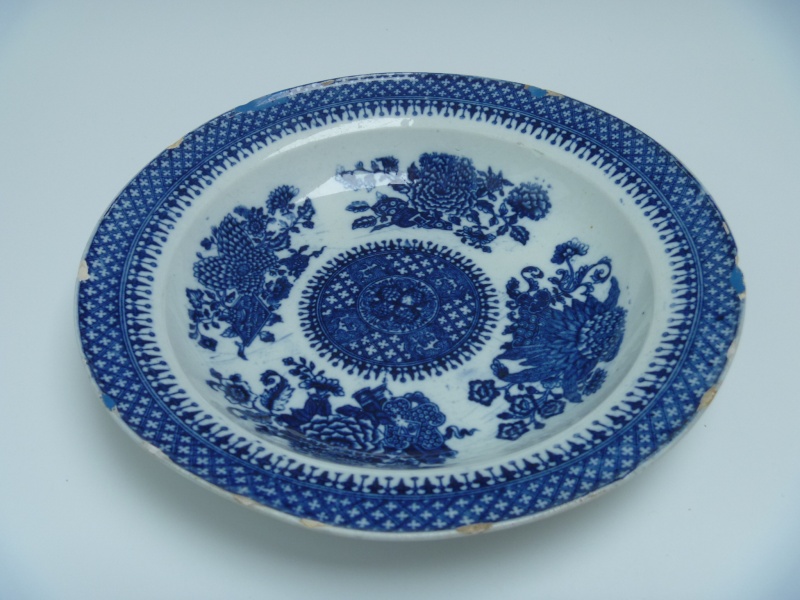

Tin glaze. At low temp earthenware firing its a nice opaque white.

climberg64- Number of posts : 1254
Location : North East
Registration date : 2010-01-20
 Re: Glaze identification
Re: Glaze identification
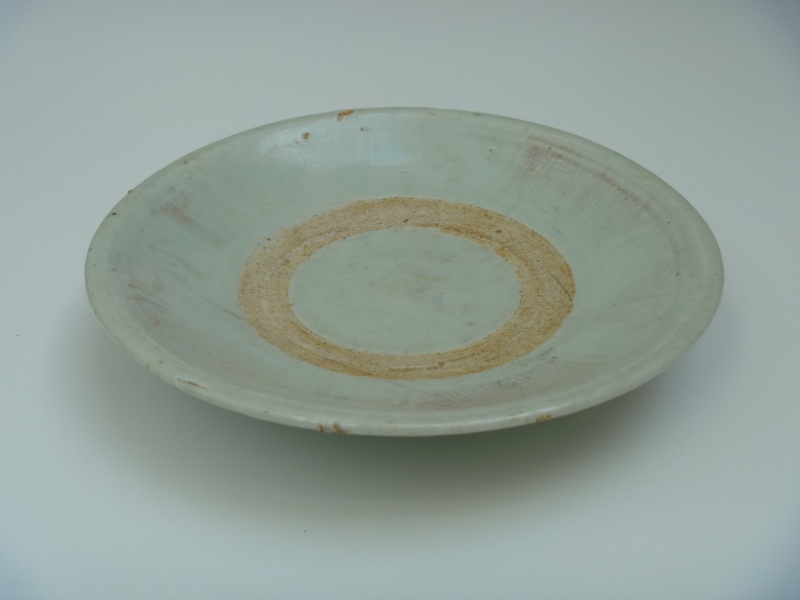

Celedon. This has thousands of tiny bubbles that makes it look soft and cloudlike. The colour white green or blue depends on the amount of iron in it.

climberg64- Number of posts : 1254
Location : North East
Registration date : 2010-01-20
 Re: Glaze identification
Re: Glaze identification
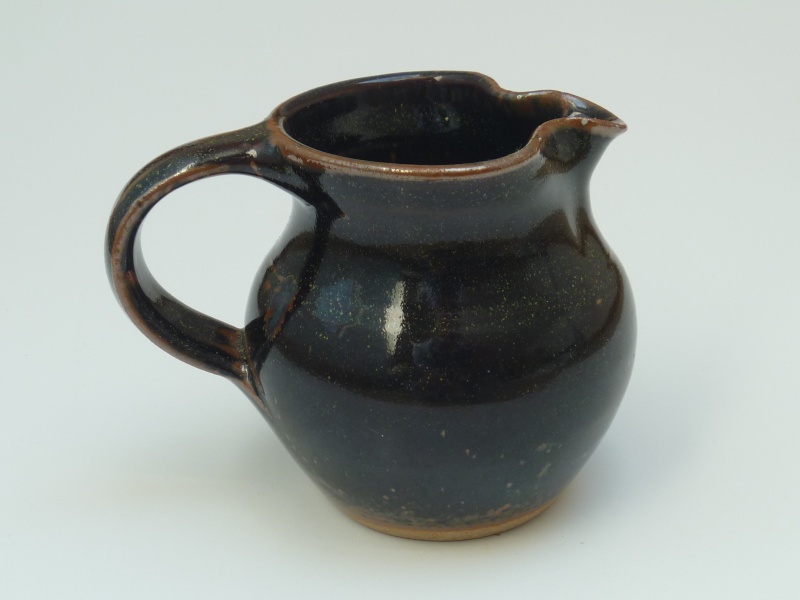

Tenmoku.

climberg64- Number of posts : 1254
Location : North East
Registration date : 2010-01-20
 Re: Glaze identification
Re: Glaze identification
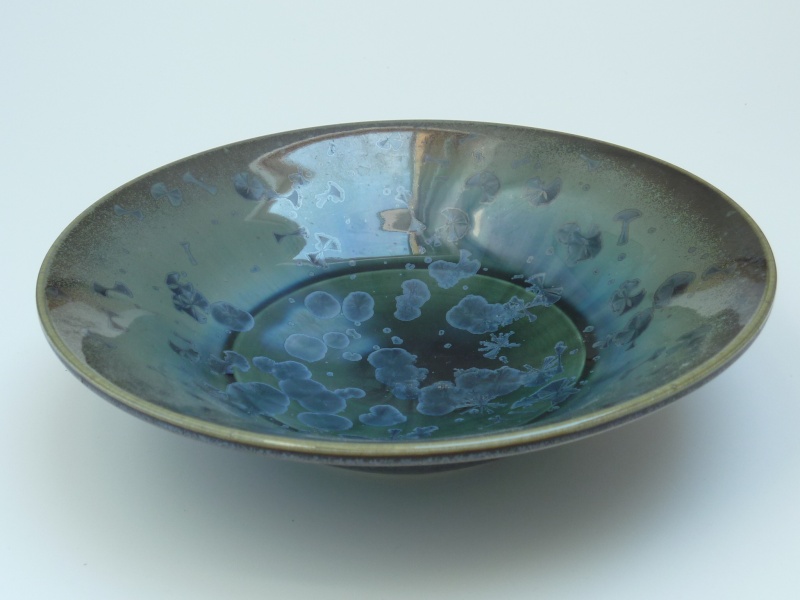
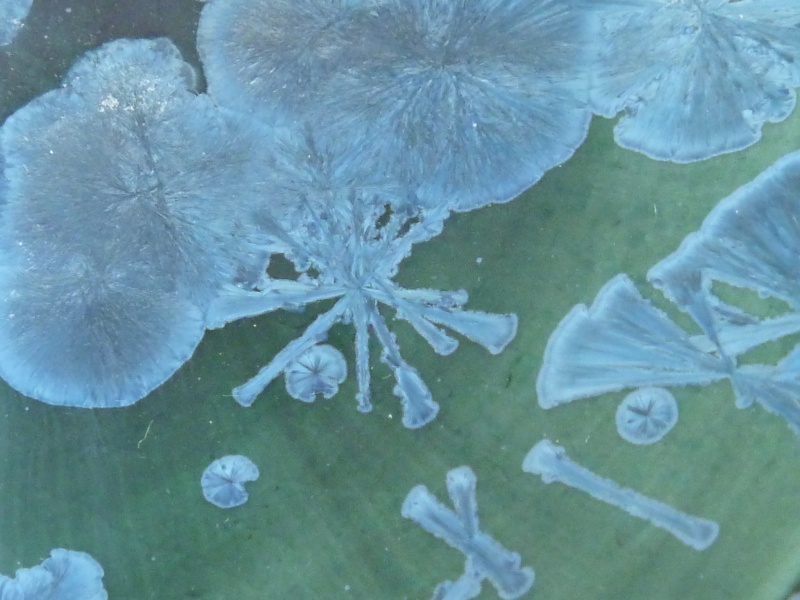
At firing temperatures the glaze is liquid. if cooled slowly crystals can form. High fired crystaline glaze bowl by John Stroomer.

climberg64- Number of posts : 1254
Location : North East
Registration date : 2010-01-20
 Re: Glaze identification
Re: Glaze identification
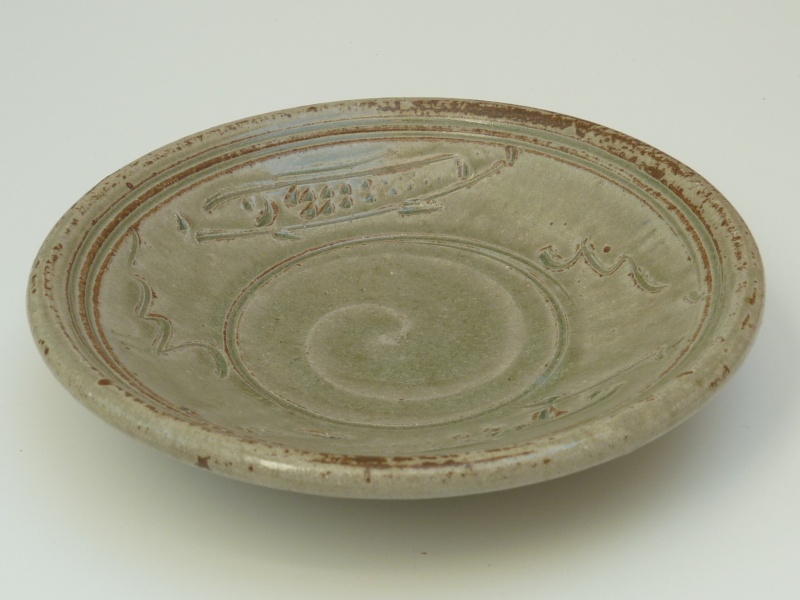
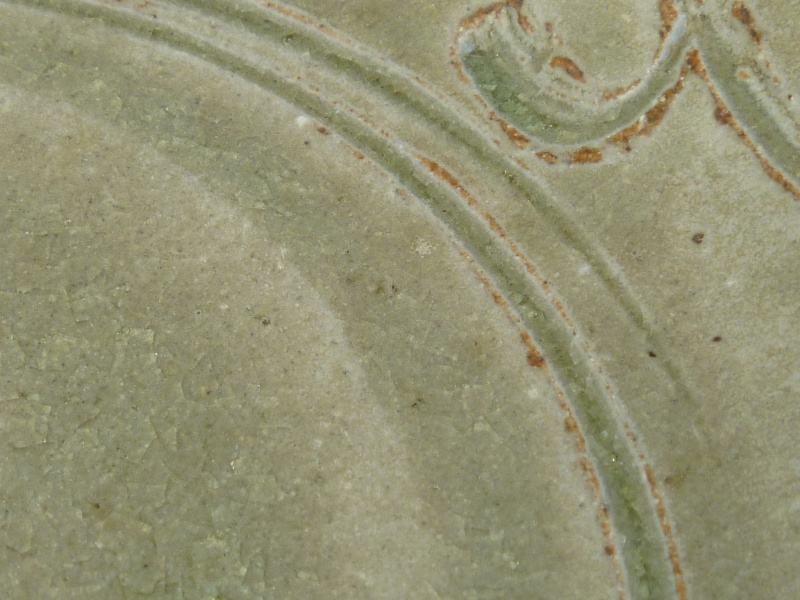
Transparent green glaze over slip. Slip is a liquid clay used under glaze as decoration - it comes in different colours. Phil Rogers bowl.

climberg64- Number of posts : 1254
Location : North East
Registration date : 2010-01-20
 Re: Glaze identification
Re: Glaze identification
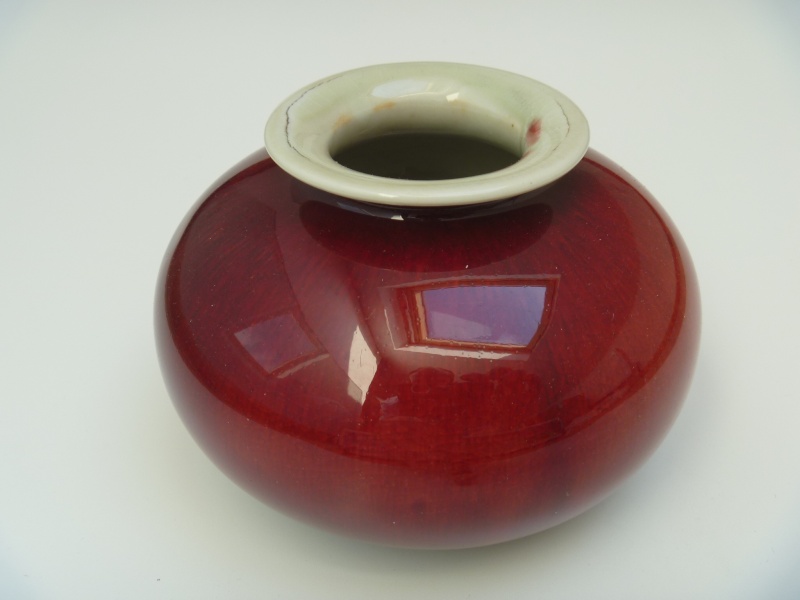
Ox blood glaze. The Chinese discovered reduction firing which produces vivid bright colours from normal glaze minerals. The English never discovered this and as a result all old English ware tends to be brown and yellow.
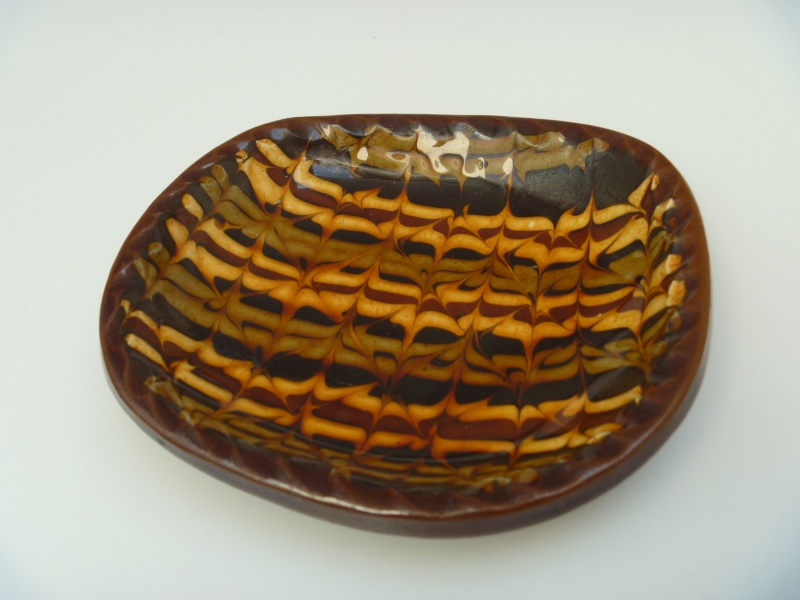
Reduction firing is done in low oxygen conditions and produces unusual brightly coloured compounds.

climberg64- Number of posts : 1254
Location : North East
Registration date : 2010-01-20
 Re: Glaze identification
Re: Glaze identification
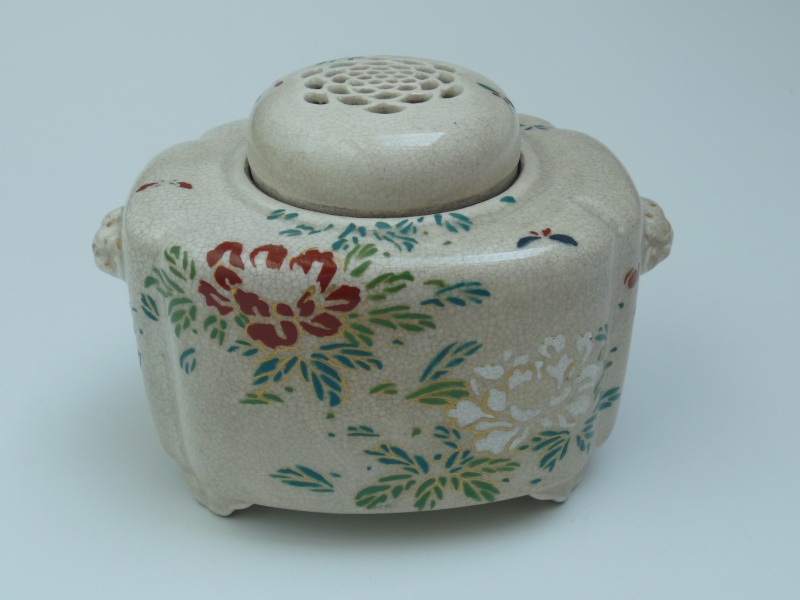

If the clay and the glaze materials expand and shrink at different amounts then crackles form.

climberg64- Number of posts : 1254
Location : North East
Registration date : 2010-01-20
 Re: Glaze identification
Re: Glaze identification
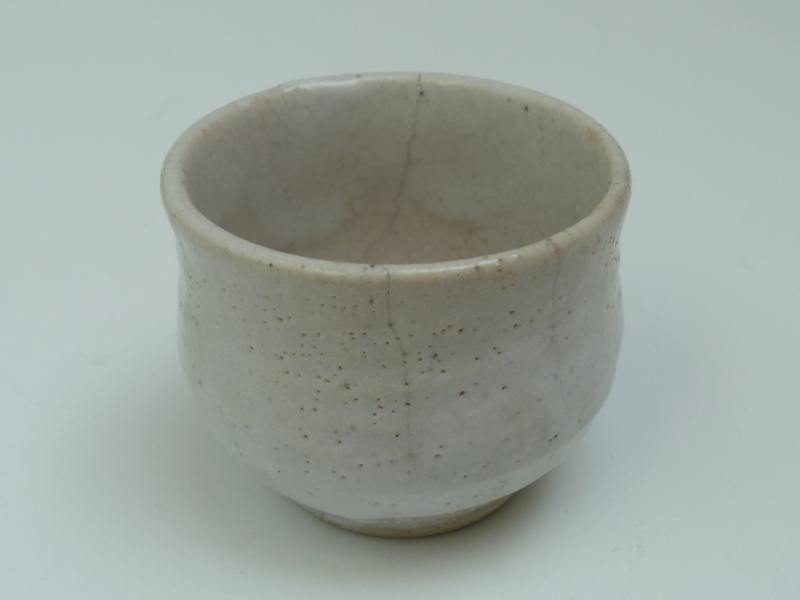
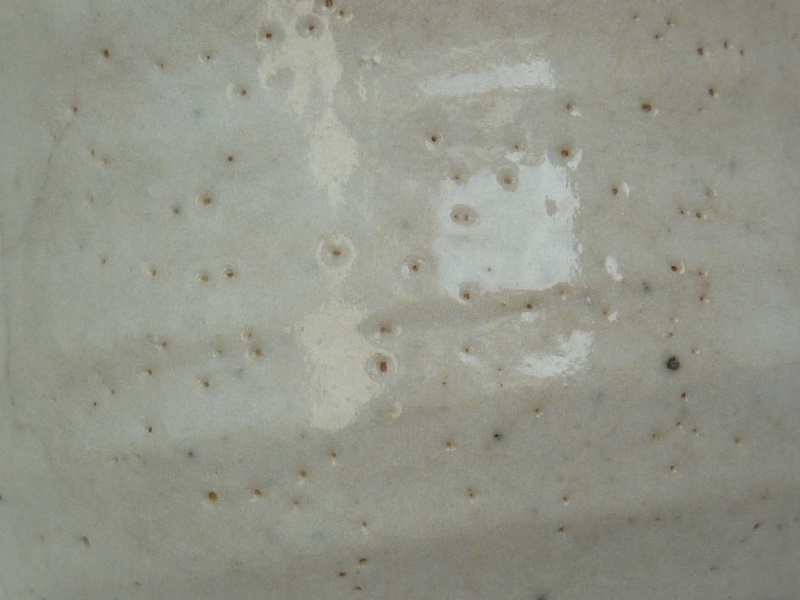
I think this is a shino glaze; opaque, white, pitted surface when low fired. Different effects occur at higher temperatures.

climberg64- Number of posts : 1254
Location : North East
Registration date : 2010-01-20
 Re: Glaze identification
Re: Glaze identification
Excellent start, hopefully others will contribute.

Nik-
 Number of posts : 265
Number of posts : 265
Location : Southport
Registration date : 2011-11-02
 Re: Glaze identification
Re: Glaze identification
climberg64 wrote:
Ox blood glaze. The Chinese discovered reduction firing which produces vivid bright colours from normal glaze minerals. The English never discovered this and as a result all old English ware tends to be brown and yellow.
Correction. The dish here is decorated with different coloured slips (liquid clays) rather than glaze (although there might be a clear glaze on top). Different clays have different ochre colours.
 Re: Glaze identification
Re: Glaze identification
Yeah. I put that up as an example of brown and yellow old English ware. But you are right, I didn't make it clear it was slip ware, thanks.

climberg64- Number of posts : 1254
Location : North East
Registration date : 2010-01-20
 Re: Glaze identification
Re: Glaze identification
NaomiM wrote:
Correction. The dish here is decorated with different coloured slips (liquid clays) rather than glaze (although there might be a clear glaze on top). Different clays have different ochre colours.
Although an email I received this morning from my potter friend told me that me talking about glazes was "being a bit assuming, and it doesn't suit you" I'll be brave and point out that slips are glazes but not all glazes are slips.
_________________
Now you should know by now that Potty and I need to see your bottom - we're funny that way!
 Re: Glaze identification
Re: Glaze identification
I still think a distinction should be made between slip-decorated slipware, be it carved or piped, and other pieces that are variously glazed.
tbh, I think this thread is a can of worms.
tbh, I think this thread is a can of worms.
_________________
Carrot cake is just fake cake
 Re: Glaze identification
Re: Glaze identification
More worms for the can.
The diffference between salt glazed wares that are produced by throwing salt (sodium chloride) into the kiln towards the end of the firing process and soda glazed pots where various carbonates of sodium are used instead of salt can be difficult to spot.
Below is a cut sided salt glazed jar on the left and a soda glazed yunomi on the right. You will note that the salt tends to give a finer more controlled overall effect than the soda, as shown here, but unfortunately that isn't always the case.

The diffference between salt glazed wares that are produced by throwing salt (sodium chloride) into the kiln towards the end of the firing process and soda glazed pots where various carbonates of sodium are used instead of salt can be difficult to spot.
Below is a cut sided salt glazed jar on the left and a soda glazed yunomi on the right. You will note that the salt tends to give a finer more controlled overall effect than the soda, as shown here, but unfortunately that isn't always the case.

_________________
Now you should know by now that Potty and I need to see your bottom - we're funny that way!
 Re: Glaze identification
Re: Glaze identification
In some wood firing processes that originate in Japan the pots go into the kiln unglazed, as the teabowl below would have done.
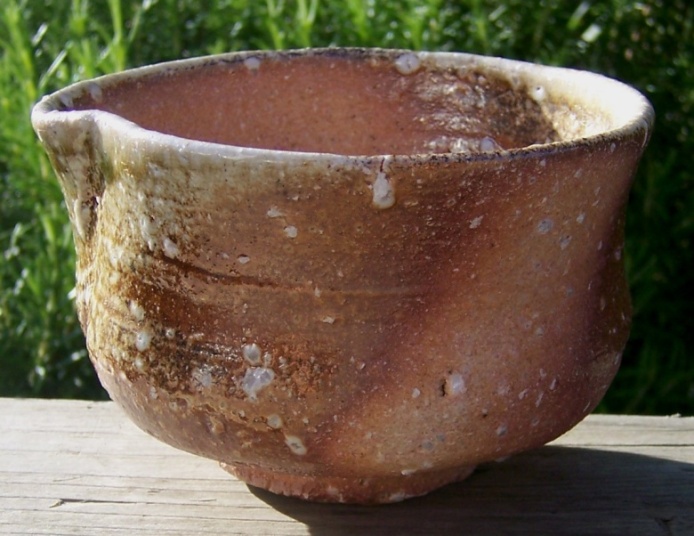
Here on the right of the teabowl you will see an area that is unglazed but the left of the bowl is glazed. This glaze all results from the wood (in this case pine) that is used to fire the kiln for several days and is due to the pine ash reacting with the stoneware body. The stoneware used in Shigaraki, where this bowl was made, has a high feldspar content (the white lumpy mineral seen within the clay), which helps and adds to the effect.
If you wish to try this at home all you will need is an anagama kiln like the one below, loads of cut firewood and the ability to stay awake for 2 to 3 days and nights to continue to stoke the kiln.


Here on the right of the teabowl you will see an area that is unglazed but the left of the bowl is glazed. This glaze all results from the wood (in this case pine) that is used to fire the kiln for several days and is due to the pine ash reacting with the stoneware body. The stoneware used in Shigaraki, where this bowl was made, has a high feldspar content (the white lumpy mineral seen within the clay), which helps and adds to the effect.
If you wish to try this at home all you will need is an anagama kiln like the one below, loads of cut firewood and the ability to stay awake for 2 to 3 days and nights to continue to stoke the kiln.

_________________
Now you should know by now that Potty and I need to see your bottom - we're funny that way!
 Re: Glaze identification
Re: Glaze identification
http://www.anagama.co.uk/index.html
This is a great website and has a section on anagama kiln firing effects- its a whole new world - fascinating.
This is a great website and has a section on anagama kiln firing effects- its a whole new world - fascinating.

climberg64- Number of posts : 1254
Location : North East
Registration date : 2010-01-20
 Re: Glaze identification
Re: Glaze identification
I have had two potters in the last month or so telling me about reduction firing , I replied "whatever" , if it looks the bizz then I am happy , some bought in glazes look awful imo and celadon is my least fav of all , blimmin horrible looking I think , I'll leave the technical stuff to the bakers who make the pots , I'll do the picking and buying and displaying , I like my cakes but can't be arsed how they are made 


big ed-
 Number of posts : 11932
Number of posts : 11932
Age : 71
Location : UK
Registration date : 2008-03-22
 Re: Glaze identification
Re: Glaze identification
Reduction firing is where air is restricted from entering the kiln and this lack of oxygen gives a different final colour with a glaze than if air (oxygen) was allowed to be present.
That's all I know and, as Ed says, far more than any pot buyer needs to know.
That's all I know and, as Ed says, far more than any pot buyer needs to know.
_________________
Now you should know by now that Potty and I need to see your bottom - we're funny that way!
 Re: Glaze identification
Re: Glaze identification
learning about the way a pot is made helps me understand and appreciate a pot, also one can often date a piece by the technique and processes employed.,
Last edited by dantheman on September 25th 2012, 12:51 pm; edited 1 time in total
_________________
'Edith Swan takes it up the Swanee and she loves it more than Christmas day.'

dantheman- Consultant

-
 Number of posts : 15463
Number of posts : 15463
Location : Lincolnshire ( the veg patch of England)
Registration date : 2008-02-03
 Re: Glaze identification
Re: Glaze identification
I can understand some folks wanting to know about all the technical side of it , especially if they want a go themselves , but for me when i'm told the temperature and how much sodium silicate, flint make slips is a no no , glazes feldspar , soda feldspar , barium (ouch), manganese , fired at 1200% in an electric kiln , I go into a trance , I bet the very first potter didn't have a clue about all that stuff , I bet stoneage potterman got some mud covered it in dye chucked it on the fire and had his first exhibition 2 weeks later , job's a goodun ., PS I do know when toast has been done on a gas grill as opposed to a toaster 


big ed-
 Number of posts : 11932
Number of posts : 11932
Age : 71
Location : UK
Registration date : 2008-03-22
 Re: Glaze identification
Re: Glaze identification
Iv'e always admired her work , I know Sam Hall has numerous firings , contrast this with Lucie Rie one Firing , different strokes for ...........

big ed-
 Number of posts : 11932
Number of posts : 11932
Age : 71
Location : UK
Registration date : 2008-03-22
 Re: Glaze identification
Re: Glaze identification
big ed wrote:Iv'e always admired her work ...
More firings means more losses during firing so less final product.
Aki has just completed a Fine Art course and is in the process of moving into a shared studio space so "Artists Beware the competition", especially those who have gone all surreal on us!

_________________
Now you should know by now that Potty and I need to see your bottom - we're funny that way!
 Re: Glaze identification
Re: Glaze identification
Real Madrid -2 .Surreal Madrid -Fish.

big ed-
 Number of posts : 11932
Number of posts : 11932
Age : 71
Location : UK
Registration date : 2008-03-22
Page 1 of 2 • 1, 2 
Page 1 of 2
Permissions in this forum:
You cannot reply to topics in this forum
